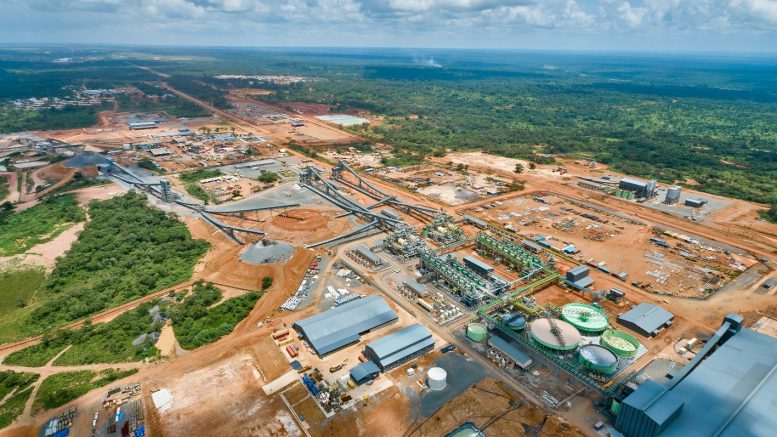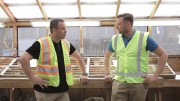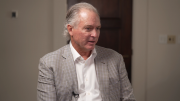Ivanhoe Mines (TSX: IVN) receives a constant stream of peers keen on learning its secrets of success in the Democratic Republic of Congo but it won’t sign a partnership deal on new discoveries as quickly as it did with Kamoa Kakula, president Marna Cloete says.
“Everybody’s been knocking on our door, trying to understand what we are doing, trying to see how we did it,” Cloete said in an interview on Tuesday with The Northern Miner in Riyadh. “Kamoa is going to throw off significant cash flow in the near future, so why dilute ourselves? We’ve got the know-how in-country, so why bring in a third-party player to complicate matters further?”
Ivanhoe, founded by industry billionaire Robert Friedland, plans to start production from its Kipushi zinc mine in the DRC in the second quarter. It wants to expand output three months later at Kamoa Kakula, the even joint venture with China’s Zijin Mining, to as much as 490,000 tonnes of copper from 393,551 tonnes last year. Ivanhoe’s Platreef platinum project in South Africa is due to start at the same time.
The Vancouver-based company is exploring the Western Forelands region in the DRC’s south. Drill results at the area’s Kitoko discovery include 3.4 metres of 3.54% copper and 6.4 metres of 4.92% copper.
Companies such as Barrick Gold (TSX: ABX; NYSE: GOLD) are keen to increase their copper output with mergers and acquisitions on expectations the metal becomes more valuable as part of the green energy transition. Cloete wouldn’t say if Barrick CEO Mark Bristow has come to call, though both attended the Future Minerals Forum in Saudi Arabia this week.
She did say Ivanhoe would have waited longer to sell a stake in Kamoa Kakula if it had a do-over and it would have remained in charge. But the collapse in commodity prices crushed other funding opportunities in 2015 when the US$412 million deal occurred, she said.
“If we had to do that transaction today, it probably would have been different,” Cloete said. “It would have been a much bigger price tag and we probably would have ensured that we maintained operational control.”
Managing risk
With a 50-50 partnership, consensus can take time when there are different ways to build projects. Nonetheless, the joint venture has worked well to manage risk while achieving goals by combining Western and Chinese approaches in a staggered approach intent on entering its third stage this year, she said.
“The Western approach is much more cautious: do a lot of study work upfront, overthink things a little bit,” she said. “The Chinese approach is much more bullish, you know, they go for it, they build it, they get it done. If there’s a problem, they’ll fix it afterwards.”
Ivanhoe is installing back-up power of 200 megawatts at Kamoa Kakula and securing an additional 30 MW from neighbouring Zambia to avoid disruptions that last year reduced copper output to the lower end of guidance. It’s also helping make US$450 million in loans available to the DRC to upgrade the grid.
Industry practice, despite the lack of advanced infrastructure in Africa, is to install back-up power only to ensure critical needs, not a large mine at full production, Cloete said.
“Kamoa Kakula is well-positioned for improved performance once power stability is achieved,” BMO Capital Markets mining analyst Andrew Mikitchook said in a note on Monday. “Together with phase three expansion expected ahead of schedule in the third quarter, Ivanhoe is positioned to deliver significant 2024 production growth.”
The DRC could have some of the continent’s largest power generation. Its Grand Inga project has been in the works for decades, eating up billions of dollars, but it still lacks a timeline for completion when some 80% of the population lives without electricity.
Assessing governance
The country, considered by some political analysts to be ungovernable because of its large size and poor roads, produces the world’s most cobalt. Ivanhoe’s copper and zinc assets at least benefit from being more than 1,000 km away from the numerous armed militias in the country’s troubled eastern region abutting Rwanda. On Wednesday, the DRC’s Constitutional Court confirmed the re-election of President Felix Tshisekedi after a December vote, even though independent observers criticized the balloting as irregular.
“It’s probably not an ideal election,” Cloete said, noting the previous vote was similar and that operating a company in the country requires accepting the baby steps of a young democracy.
“It’s about spending the time and the hours in the saddle to understand the landscape. And then it’s about doing things the right way. For example, if you get asked for supporting an election, you can say ‘we can build a university.’”
Western governments such as the United States, Canada and the European Union are handing out billions of dollars for critical minerals development, but those projects can be just as risky as those in Africa when considering permit reviews or anti-mining activism, Cloete said.
Operating in jurisdictions perceived as risky such as the DRC and South Africa, which is plagued with power outages, often requires more spending on roads and electricity than other regions. It also means community development work, and local recruitment and procurement, she said.
Ivanhoe’s contribution to the DRC economy last year is expected to be a double-digit percentage of its gross domestic product.
“I’m from Africa and that’s my backyard. That’s what we know how to do. That’s what we do well, so others see risky jurisdictions and we see an opportunity,” she said. “It’s really transformative what a discovery like Kamoa Kakula can do to the economy.”






Be the first to comment on "Exclusive: Ivanhoe’s Congo copper is what everyone’s after, Cloete says"